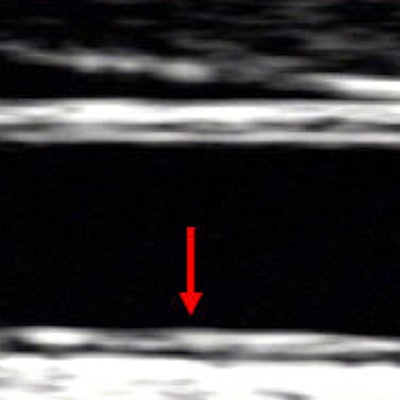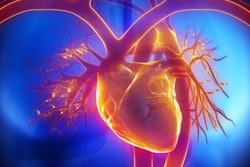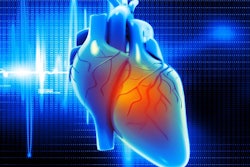
Can coronary CT angiography (CCTA) be performed on asymptomatic individuals before they have a cardiovascular event such as a heart attack? Italian researchers found a way to efficiently deploy CCTA screening, and shared their technique in a 14 October article in the European Heart Journal.
Researchers assessed the effectiveness of biomarkers like C-reactive protein (CRP) and interleukin (IL) levels, as well as signs of carotid artery disease, and added them more predictable markers of age, male gender, and diabetes, to figure out which asymptomatic individuals might be at risk of heart disease, and thus would benefit from screening.
"We have shown that asymptomatic male and diabetic subjects with high interleukin-6 values in conjunction with carotid artery disease have a very high probability to manifest obstructive coronary artery disease or multivessel disease or coronary atherosclerotic high-risk plaque," wrote radiologist and cardiologist Dr. Andrea Igoren Guaricci from the University of Bari's Azienda Consorziale University Hospital Polyclinic in Bari, Italy.
 Above, ultrasound finds carotid disease. Images courtesy of Dr. Andrea Igoren Guaricci.
Above, ultrasound finds carotid disease. Images courtesy of Dr. Andrea Igoren Guaricci.Triage with CCTA plus biomarkers
Combining carotid disease evaluation with assessment of inflammatory markers could help clinicians select the subset of asymptomatic patients who need a referral to CCTA for screening, the study team added. Certainly there are many good reasons to look for better ways to assess cardiovascular risk, Guaricci stated.
"It is devastating to learn that myocardial infarction represents the first clinical manifestation of coronary artery disease in up to 65% of previously asymptomatic patients," he wrote in an email. "Moreover, thinking that the total direct medical costs of cardiovascular disease are projected to rise three-fold in the next 25 years, we understand that a major need is represented by more effective strategies aimed at the prevention of unheralded cardiovascular events."
Current risk assessment is plagued by very modest predictive accuracy, and evaluation is very costly for cardiovascular events in intermediate-risk subjects, the authors wrote.
Carotid artery disease has previously been identified as an independent predictor of myocardial infarction and stroke, and assessment of inflammatory activation
may be also useful for risk stratification of individuals with coronary artery disease.
Ongoing debate about the cost and radiation exposure make the use of CCTA impractical for use on the entire population. The availability of better nonimaging biomarkers to predict risk could be very helpful in referring patients at risk to CCTA screening.
Potential for better risk assessment
Therefore, the study sought to evaluate the integrated value of inflammatory biomarkers and carotid artery disease in identifying asymptomatic individuals at higher risk for cardiac events.
The investigators enrolled 134 consecutive and asymptomatic individuals at intermediate risk of coronary artery disease (mean age 61 + 9 years, 52% men). Candidates were excluded for history of cardiac disease, contraindications to CCTA, autoimmune disease, and use of anti-inflammatory drugs within one month.
Each subject was tested for circulating levels assessment of interleukin (IL)-2r, IL-6, IL-8, IL-10) as well as high-sensitivity C-reactive protein (hs-CRP) and carotid and coronary artery evaluation using carotid ultrasound and CCTA, respectively. Carotid disease was diagnosed in 71 (53%) patients.
Ultrasound for carotid evaluation was performed on a gray-scale ultrasound scanner (Hawk 2002, BK Medical) with a multifrequency linear probe. ECG-gated coronary CTA images were acquired on a 64-detector row scanner (Aquilion, Toshiba Medical Systems) following intravenous administration of contrast media and beta-blockers. Coronary calcium scoring was performed before contrast administration. Two experienced readers working in consensus used an offline workstation (Vitrea, Vital Images) to interpret the CT images using the 16-segment American Heart Association Model.
Carotids, biomarkers can boost risk assessment
Results in 134 subjects showed that certain biomarkers were associated with the presence or severity of coronary artery disease in asymptomatic individuals at risk.
- Subjects with no or nonobstructive coronary disease had a lower rate of carotid disease (43%) than those with obstructive disease, but they had no significant difference in interleukin levels, except for IL6 (p < 0.028), the group wrote.
- Subjects with multivessel coronary disease at CCTA had a higher rate of carotid disease (89% versus 46%, p < 0.001) and higher values for all interleukins compared with patients without multivessel coronary disease.
- Tumoral necrosis factor (TNF-a) values were also significantly higher in patients with significant multivessel coronary disease (50%, p < 0.022) versus those without it (p < 0.019).
- Male gender, diabetes, carotid disease, and IL-6 were independently associated with obstructive coronary artery disease at both univariate and multivariate analyses.
- The multivariate models showed the highest accuracy when compared with male gender (80%, p < 0.03), IL-6 (58%, p < 0.005), and carotid disease (62%, p < 0.0003), the authors wrote.
- Notably, the multivariate model was associated with a higher prediction accuracy for obstructive coronary disease than other models, even when compared with the two key risk factors of male gender and diabetes.
"The most interesting evidence is that simple examinations consisting in carotid artery ultrasound evaluation, together with a blood sample, is very useful to understand which patients could be affected by a serious coronary artery disease and thus deserve further diagnostic steps," Guaricci noted. "So probably asymptomatic, middle-aged people with traditional cardiovascular risk factors such as diabetes or dyslipidemia should check their carotid arteries and markers of inflammation (IL-6)."
Carotid disease has been used as a general marker of atherosclerosis before, but this is probably the first study to show that asymptomatic male and diabetic subjects with high IL-6 values in conjunction with carotid artery disease have a very high probability to manifest obstructive CAD or multivessel disease or coronary atherosclerotic high-risk plaque, Guaricci and colleagues wrote.
Another possible test, carotid intima-medial thickness (CIMT) to predict cardiovascular events remains controversial, as a meta-analysis showed that carotid plaque detection is more accurate for predicting future events than CIMT. Another study found that carotid stenosis and CAD extent were poorly coordinated.
A gatekeeper for radiation-bearing exams
CCTA is a robust diagnostic test but has "limited use for a screening strategy in asymptomatic patients due to its cost and radiation exposure," the authors wrote. "Therefore, the identification of noninvasive multiparametric approach without the use of ionizing radiation to identify which patients among asymptomatic population really need to be referred to CCTA is of interest."
Assuming that clinicians don't immediately start testing for inflammatory markers, would more carotid ultrasound be a step in the right direction?
"The carotid intima media thickness together with assessment of carotid plaques are correlated to the incidence of cerebrovascular events and should be adopted more extensively especially in presence of other traditional risk factors," Guaricci wrote.
In its next study, the team plans to delve further into whether ultrasound assessment of the carotid arteries in asymptomatic patients is able to predict cardiac events, and whether it increases the prognostic power of other tools such as CCTA, he said.



















